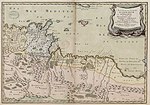Banu Khurasan بني خراسان | |||||||||
|---|---|---|---|---|---|---|---|---|---|
| c. 1058–1159 | |||||||||
| Capital | Tunis | ||||||||
| Common languages | Arabic, Berber | ||||||||
| Religion | Islam (Sunni) | ||||||||
| Government | Monarchy | ||||||||
| Emir | |||||||||
• 1058-1095 | Abd al-Haqq ibn Abd al-Aziz ibn Khurasan | ||||||||
• 1149-1159 | Abd Allah ibn Abd al-Aziz | ||||||||
| Historical era | Middle Ages | ||||||||
• Established | c. 1058 | ||||||||
• Disestablished | 1159 | ||||||||
| |||||||||
| History of Tunisia |
|---|
 |
|
|
The Banu Khurasan (Arabic: بنو خراسان, romanized: Banu Khurasan)[1] or Khurasanid dynasty[2] was a Sunni Muslim dynasty that ruled an independent principality centered on Tunis, in present-day Tunisia, between approximately 1058 and 1159.[1] They rose to power following the political vacuum left behind by the Zirids when they abandoned Kairouan for Mahdia in 1157, in the face of pressure from the Banu Hilal. While de facto independent, they continued to recognize the suzerainty of either Zirids or the Hammadids for much of this period. Their rule was interrupted by Hammadid annexation from 1128 and 1148, and their authority came to a final end with the Almohad conquest in 1159.[1]
- ^ a b c Valérian, Dominique (2021). "Khurāsān, Banū". In Fleet, Kate; Krämer, Gudrun; Matringe, Denis; Nawas, John; Rowson, Everett (eds.). Encyclopaedia of Islam, Three. Brill. ISBN 9789004161658.
- ^ Ars Orientalis: The Arts of Islam and the East. Freer Gallery of Art. 1957. p. 561.